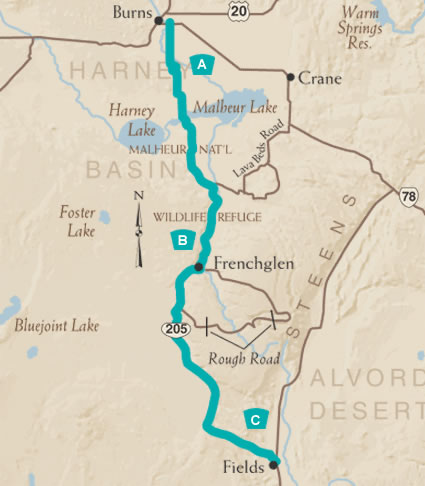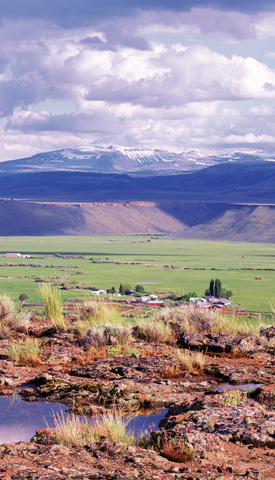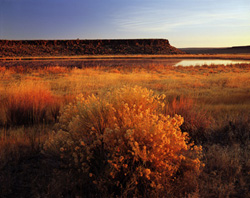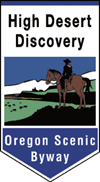The High Desert Discovery Scenic Byway

The High Desert of Harney County is a far cry from the Oregon west of the Cascades. Covered with juniper and sagebrush and dotted with dramatic mountain ranges, this is true frontier country, a remnant of the Wild West. The High Desert Discovery Scenic Byway guides you through the heart of this sparsely populated region, offering broad panoramas of wide-open spaces so seldom encountered today. This byway serves as a gateway to awe-inspiring Steens Mountain, the Diamond Craters, the Malheur National Wildlife Refuge, the Hart Mountain National Antelope Refuge, the Peter French Round Barn and the Alvord Desert. Its austere beauty offers incredible solitude; alone in the high desert, you feel a bit like a cowboy or pioneer from another era. As a modern day pioneer exploring this frontier, plan accordingly as basic services are few and far between.
A. Burns To The Refuge
 The
High Desert Discovery Scenic Byway begins at Burns, which rests at the
junction of Highways 20, 78 and 395. From Burns, proceed south on Highway
205. Wright's Point provides stunning views of the Blue Mountains to the
north and Steens Mountain to the south. At the Narrows interpretive site,
Mud Lake and Harney Lake offer pleasant vistas to the west. To the east,
Malheur Lake and the Malheur National Wildlife Refuge presents a veritable
oasis amidst the arid range lands. The Refuge stretches 39 miles wide
and 40 miles long, and is home to 320 bird species. Spring is the most
spectacular season. Northern pintails and tundra swans begin to arrive
followed by sandhill cranes and large concentrations of snow, Ross' and
white-fronted geese. Waterfowl, shorebirds and songbirds hit high number
peaks as well. As the flurry of migration settles, broods of trumpeter
swans and other waterfowl can be seen on most Refuge ponds and migrant
shorebirds congregate on mud flats and alkali playas. Activity increases
again in the fall as migration begins. One of the Refuge's greatest attractions
occurs when greater sandhill cranes "stage," or gather, in the
southern Blitzen Valley. Also look for large flocks of ducks, Canada geese
and tundra swans. Winter is the quietest season at the Refuge although
a variety of raptors, including bald eagles and rough-legged hawks can
be seen.
The
High Desert Discovery Scenic Byway begins at Burns, which rests at the
junction of Highways 20, 78 and 395. From Burns, proceed south on Highway
205. Wright's Point provides stunning views of the Blue Mountains to the
north and Steens Mountain to the south. At the Narrows interpretive site,
Mud Lake and Harney Lake offer pleasant vistas to the west. To the east,
Malheur Lake and the Malheur National Wildlife Refuge presents a veritable
oasis amidst the arid range lands. The Refuge stretches 39 miles wide
and 40 miles long, and is home to 320 bird species. Spring is the most
spectacular season. Northern pintails and tundra swans begin to arrive
followed by sandhill cranes and large concentrations of snow, Ross' and
white-fronted geese. Waterfowl, shorebirds and songbirds hit high number
peaks as well. As the flurry of migration settles, broods of trumpeter
swans and other waterfowl can be seen on most Refuge ponds and migrant
shorebirds congregate on mud flats and alkali playas. Activity increases
again in the fall as migration begins. One of the Refuge's greatest attractions
occurs when greater sandhill cranes "stage," or gather, in the
southern Blitzen Valley. Also look for large flocks of ducks, Canada geese
and tundra swans. Winter is the quietest season at the Refuge although
a variety of raptors, including bald eagles and rough-legged hawks can
be seen.
B. On To Frenchglen
Skirting the marshes of the Malheur National Wildlife Refuge, you'll soon pass the turnoff for the Diamond Loop Tour Route, which leads to the Peter French Round Barn. Continue to follow the route that parallels ancient basalt flows until you reach the southern end of the Blitzen Valley and the community of Frenchglen. Frenchglen provides services for Steens Mountain visitors and is the point of departure for the Steens Loop Tour Route. You may also access the Donner und Blitzen River from here which offers excellent angling for redband trout, a species of rainbow trout indigenous to the high desert region. Other outdoor activities within the area include hiking, horseback riding, camping, birding, and winter recreation. One of the focal points of Frenchglen is the historic Frenchglen Hotel which was built in the mid-1920s and remodeled in 1938 by the Civilian Conservation Corps. It's an excellent example of American Foursquare architecture and is still open today, providing lodging and family-style meals.
C. Catlow Rim to Fields
 Heading
south from Frenchglen, you'll soon pass the turnoff for the Hart Mountain
National Antelope Refuge. This primitive road leads to the 275,000 acres
of high-desert habitat that was set aside in 1936 to provide spring, summer
and fall range for the region's pronghorn antelope herds. Continuing south,
Route 205 parallels Catlow Rim and Catlow Valley, home to some of the
region's wild horse herds and big horn sheep which can frequently be seen
from the road. The High Desert Discovery Byway ends in the ranching community
of Fields. At the turn of the century, borax was collected around Borax
Lake, providing a significant source of revenue. Fields is an excellent
staging area for outdoor adventures in the nearby Trout Creek and Pueblo
Mountains. The privately owned Alvord Hot Springs is currently open for
public use. Fields offers some essential traveler's services such as food,
gas and lodging. From here, you can loop north on the East Steens Tour
Route, which ends back in Burns.
Heading
south from Frenchglen, you'll soon pass the turnoff for the Hart Mountain
National Antelope Refuge. This primitive road leads to the 275,000 acres
of high-desert habitat that was set aside in 1936 to provide spring, summer
and fall range for the region's pronghorn antelope herds. Continuing south,
Route 205 parallels Catlow Rim and Catlow Valley, home to some of the
region's wild horse herds and big horn sheep which can frequently be seen
from the road. The High Desert Discovery Byway ends in the ranching community
of Fields. At the turn of the century, borax was collected around Borax
Lake, providing a significant source of revenue. Fields is an excellent
staging area for outdoor adventures in the nearby Trout Creek and Pueblo
Mountains. The privately owned Alvord Hot Springs is currently open for
public use. Fields offers some essential traveler's services such as food,
gas and lodging. From here, you can loop north on the East Steens Tour
Route, which ends back in Burns.






